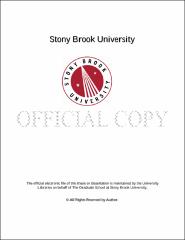| dc.identifier.uri | http://hdl.handle.net/11401/76127 | |
| dc.description.sponsorship | This work is sponsored by the Stony Brook University Graduate School in compliance with the requirements for completion of degree. | en_US |
| dc.format | Monograph | |
| dc.format.medium | Electronic Resource | en_US |
| dc.language.iso | en_US | |
| dc.publisher | The Graduate School, Stony Brook University: Stony Brook, NY. | |
| dc.type | Dissertation | |
| dcterms.abstract | Horizontal dispersion process, which is controlled by current shears, determines the residence time and inner connectivity in coastal lagoons. Great South Bay (GSB), NY is a shallow coastal lagoon which has long suffered from eutrophication and harmful algal blooms and is presently the focus of an intensive ecosystem based management study including the development of an ecological model. Current and water level observations and hindcast simulations using a three-dimensional hydrodynamic model were used to examine the structure of tidal and wind-driven circulation in GSB, and the influence of this structure on horizontal dispersion. Results confirm that circulation in the interior of GSB is primarily wind-driven. Momentum diagnostics contribute to our understanding of dynamics controlling the longitudinal and lateral circulation. At synoptic periods, the longitudinal momentum balance involves primarily barotropic pressure gradient and stress divergence; baroclinic pressure gradient and Coriolis force also contribute to the lateral momentum balance. Observations indicate that vertical structures of both longitudinal and lateral currents are consistent with simple model involving surface and bottom log layers and a linear stress profile within the interior of the water column. Longitudinal currents are highly sheared laterally, with maximum shear occurring over strong bottom slopes between the channel and shoals. Lateral currents are less organized and have direction reversed over small distance along lagoon axial. Lagrangian particle tracking algorithm was implemented based on current field from the hydrodynamic model to quantify the horizontal shear dispersion, residence times, and inner-lagoon connectivity within GSB. The largest longitudinal dispersion rate was over 60 m^2/s and was associated with the interaction of laterally-sheared longitudinal currents and lateral mixing; lateral dispersion ranged from 0.1 to 1〖 m〗 ^2/s and was mainly explained by the longitudinal shear dispersion. For dispersion in both horizontal directions, oscillatory and steady flows made comparable contribution. Results emphasize the influence of synoptic period wind forcing on the interior connectivity pattern in GSB. | |
| dcterms.available | 2017-09-20T16:42:26Z | |
| dcterms.contributor | Wilson, Robert E | en_US |
| dcterms.contributor | Flagg, Charles | en_US |
| dcterms.contributor | Hameed, Sultan | en_US |
| dcterms.contributor | Chant, Robert | en_US |
| dcterms.contributor | Thompson, Keith | en_US |
| dcterms.contributor | Munch, Stephan. | en_US |
| dcterms.creator | Yang, Dongming | |
| dcterms.dateAccepted | 2017-09-20T16:42:26Z | |
| dcterms.dateSubmitted | 2017-09-20T16:42:26Z | |
| dcterms.description | Department of Marine and Atmospheric Science. | en_US |
| dcterms.extent | 133 pg. | en_US |
| dcterms.format | Monograph | |
| dcterms.format | Application/PDF | en_US |
| dcterms.identifier | http://hdl.handle.net/11401/76127 | |
| dcterms.issued | 2015-08-01 | |
| dcterms.language | en_US | |
| dcterms.provenance | Made available in DSpace on 2017-09-20T16:42:26Z (GMT). No. of bitstreams: 1
Yang_grad.sunysb_0771E_12116.pdf: 5667245 bytes, checksum: 8aee07977a8cb91934d3a9497e90acea (MD5)
Previous issue date: 2014 | en |
| dcterms.publisher | The Graduate School, Stony Brook University: Stony Brook, NY. | |
| dcterms.subject | connectivity, Great South Bay, horizontal dispersion, Markov Chain, residence time | |
| dcterms.subject | Physical oceanography | |
| dcterms.title | Wind-driven dispersion, residence time and connectivity of Great South Bay | |
| dcterms.type | Dissertation | |

